According to a new study released in September of 2019 by the National Association of Professional Employer Organizations (NAPEO), businesses that outsource their HR services to a PEO (Professional Employer Organization) have an annual return on investment of 27.2% in cost savings alone.
This research, conducted by an independent analytics research firm called McBassi, found three areas where PEOs deliver significant value to their clients:
- Improving clients’ ability to attract, motivate, and retain employees
“PEOs offer a much broader array of benefits to their employees, such as greater access to retirement plans. Consistent with this, we found PEO clients also have significantly higher employee satisfaction as well as lower rates of employee turnover.”
- Enabling clients to focus on their core businesses while PEOs handle all HR matters
“PEO clients grow faster and are much more likely to stay in business than [their non-PEO counterparts]."
- Lowering HR-related expenditures
This component to the study only focused on the five HR-related areas of: HR personnel costs, health benefits, workers’ compensation, unemployment insurance, and other external expenditures related to HR services (payroll, benefits, etc). After calculating these costs, the study concluded “that for every $1,000 spent on PEO services, an average client would save $1,272, yielding a net (cost savings) benefit of $272 for every $1,000 spent.”
Key Findings of the 2019 NAPEO Study “The ROI of Using a PEO”
While other NAPEO studies have supported these findings over the years, the 2019 analysis more explicitly revealed the following:
- “There is notably lower employee turnover (both voluntary and involuntary) among PEO clients;
- There are higher rates of both employee growth and business revenue growth among PEO clients;
- Fewer PEO clients expressed moderate or major concerns about hiring, retaining, and motivating employees; and
- New PEO clients often add a variety of new benefits for their employees, with life insurance, retirement plans, and health benefits the categories most frequently added by new PEO clients.”
How do PEOs save client companies time and money?
Most smaller organizations typically have a “bare bones” HR functionality, which usually focuses on the most basic HR needs. Even these basics can be time-consuming, distracting, and fraught with potential for error.
When a small business works with a PEO for HR, the PEO takes over these key HR responsibilities for their clients, administering employee payroll and benefits, personnel management, workers’ compensation services, and monitoring and managing risk in these areas.
In addition, PEOs make available to their clients a broad range of additional employee-related services and technology, as well as hands-on expertise. The PEO advises on issues such as avoiding discrimination, employee retention, and up-to-date information on changing employment laws that may affect clients. Each of these other services generates advantages for the business and/or its employees.
PEO clients also have access to a broader range of HR-related benefits and services yet spend less on HR administration than peers. The greater availability of employer-sponsored retirement plans (and other employee benefits) helps businesses attract and retain their employees.
Freed from many HR administrative burdens, executives and managers of PEO clients can focus more of their time on strategy and growth, with the results being higher growth rates and higher likelihood of survival year in and year out.
Using a PEO Creates a Competitive Advantage
Achieving sustainable competitive advantage through better management of employees is a huge challenge for even the largest and most sophisticated companies. That challenge is even greater for small business and mid-size organizations.
PEOs help their clients tackle this by managing the “people side” of their businesses more effectively, avoiding compliance pitfalls, and creating key benefits for the business and its employees. This happens while simultaneously freeing up time for owners and executives to concentrate on growing their businesses by focusing on operations, strategy, and innovation.
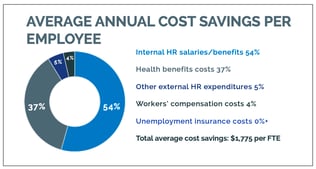
ROI of a PEO: Total average cost savings of $1,775 per FTE per year.
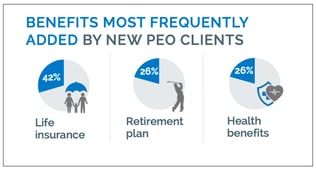
New clients typically add life insurance, retirement, and health benefits to their existing benefits package.
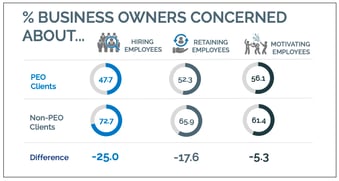
ROI of a PEO: PEO clients are less concerned about hiring, retaining, and motivating employees.
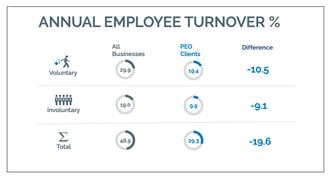
PEO clients experience higher growth rates than those who don't outsource to a PEO.
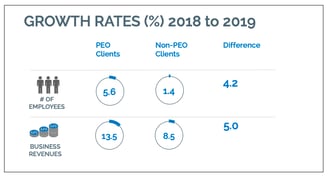
ROI of a PEO: PEO clients have less turnover (voluntary and involuntary) than those who don't outsource to a PEO.
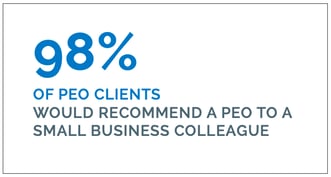
Related articles: